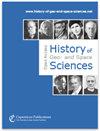角冈磁观测站的历史
IF 0.4
4区 哲学
Q4 GEOSCIENCES, MULTIDISCIPLINARY
引用次数: 0
摘要
摘要角冈磁测站(KMO)由中央气象台(CMO,后来的日本气象厅)于1913年创建,是东京磁测站的继任者。Kakioka是一个村庄70 东京以北公里处,被选中躲避东京电车噪音。起初,它是一个无人值守的天文台,只用于地磁场观测。1923年关东大地震改变了KMO的命运,因为地震严重损坏了东京的CMO,KMO的记录文件也丢失了。KMO于1924年成立,并被重新设计为地球物理而非地磁研究所。到20世纪40年代,KMO进行了各种观测,如大气电场、地电场、地震活动、气温、风速、太阳黑子和日珥以及地磁场。此外,在第一任所长今道水一的领导下,研究活动蓬勃发展。1945年第二次世界大战结束后,KMO在日本成立了几个分支天文台,最初用于地电场观测,从而形成了一个天文台网络。Memambetsu和Kanoya的两个分支天文台幸存下来,国际地球物理年项目(1957–1958)增加了地磁场观测。20世纪50年代至70年代,开发地磁绝对测量仪器和高采样记录系统的努力导致了1972年Kakioka自动标准磁强计(KASMMER)系统的开发。KASMMER每3年测量一次地磁场 s在数字形式上处于世界最高标准,给出1 可用地磁场的最小数字值。该系统进行了更新,并将高采样技术应用于地电场观测和大气电场观测。后来,除了1971年在赤岛进行的地磁场观测外,KMO还在角冈、梅门别须、Kanoya和赤岛建立了一个独特的电磁观测网络,并提供了精确和高速的采样数据(1 最小值,1和0.1 s值)。另一方面,在政府的改革政策之后的过去几十年里,KMO逐渐终止或自动化了他们的观察,并减少了他们的工作人员。2011年,位于梅曼贝苏和卡诺亚的两个分支天文台无人值守,当时梅曼贝索的大气电场也终止了。2021年,Kakioka、Memambetsu和Kanoya的地电场观测以及Kakiokka的大气电场观测都结束了。KMOf目前专注于地磁观测,并致力于火山的总作用力观测和历史模拟数据的数字化。本文章由计算机程序翻译,如有差异,请以英文原文为准。
History of Kakioka Magnetic Observatory
Abstract. Kakioka Magnetic Observatory (KMO) was founded in 1913 by
the Central Meteorological Observatory (CMO, later the Japan Meteorological Agency) as a successor to Tokyo Magnetic Observatory. Kakioka was a village 70 km north of Tokyo and was selected to escape from tram noise in Tokyo. At first, it was an unstaffed observatory only for geomagnetic field observation. Then, the Great Kanto Earthquake in 1923 changed the fate of
KMO because the earthquake severely damaged the CMO in Tokyo, and recording papers of KMO were lost. KMO was staffed in 1924 and was redesigned as an institute for geophysics rather than geomagnetism. KMO operated a variety of
observations, such as the atmospheric electric field, the geoelectric field, the seismicity, the air temperature, the wind velocity, the sunspot and
solar prominence as well as the geomagnetic field, by the 1940s. In addition, research activity flourished with the leadership of the first director, Shuichi Imamichi. After World War II was over in 1945, KMO formed a
network of observatories in Japan by founding several branch observatories
originally for geoelectric field observation. Two branch observatories at Memambetsu and Kanoya survived, with geomagnetic field observation added in the International Geophysical Year project (1957–1958). Efforts in development of instruments for geomagnetic absolute measurement and systems of high-sampling recordings in the 1950s to 1970s resulted in the development of the Kakioka Automatic Standard Magnetometer (KASMMER) system in
1972. KASMMER measured the geomagnetic field every 3 s at the highest standard in the world in digital form, giving 1 min digital values of the geomagnetic field available. This system has been updated, and
the high-sampling technology was applied to geoelectric field observation and atmospheric electric field observation. Later, adding
geomagnetic field observation at Chichijima in 1971, KMO established a unique electric and magnetic observation network at Kakioka, Memambetsu,
Kanoya and Chichijima and provided precise and high-speed sampling data
(1 min, 1 and 0.1 s values) by 2001. On the other hand, KMO gradually
terminated or automated their observations and reduced their staff in the last several decades following the government's reform policy. The two branch
observatories at Memambetsu and Kanoya were unstaffed in 2011, and the atmospheric electric field at Memambetsu was terminated at that time. The
geoelectric field observations at Kakioka, Memambetsu and Kanoya were
terminated in 2021 as well as the atmospheric electric field at Kakioka. KMO
focuses on geomagnetic observation for now and puts efforts into total force observation at volcanoes and the digitization of historic analog
data.
求助全文
通过发布文献求助,成功后即可免费获取论文全文。
去求助
来源期刊

History of Geo- and Space Sciences
GEOSCIENCES, MULTIDISCIPLINARY-HISTORY & PHILOSOPHY OF SCIENCE
CiteScore
1.50
自引率
33.30%
发文量
10
审稿时长
50 weeks
期刊介绍:
The scope of History of Geo- and Space Sciences (HGSS) is to document historical facts and knowledge and to improve awareness of the history of geoscience. The knowledge of the development of geosciences and their experimental methods and theories in the past can improve our current understanding and may stimulate current research. It is encouraging for young scientists to read biographical material of historical figures in their research area. It is important as well to learn that history of science is an integrated part of the ongoing research in their research area. Another important aim of the journal is the association of historical retrospective and current research.
 求助内容:
求助内容: 应助结果提醒方式:
应助结果提醒方式:


